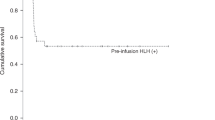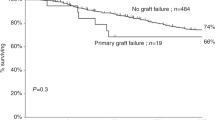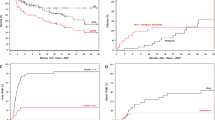Abstract
Allogeneic hematopoietic cell transplantation (HCT) in patients with Hurler's syndrome can improve survival and ameliorate many aspects of Hurler's syndrome including neurologic decline and cardiac compromise. Unfortunately, the toxicity of traditional preparative regimens to organs affected by the syndrome may have deleterious effects. Additionally, despite the intensity of these regimens, achieving stable donor chimerism can be difficult. We report transplant outcomes following a reduced intensity, highly immunosuppressive preparative regimen consisting of alemtuzumab, fludarabine and melphalan prior to HCT in seven patients with Hurler's syndrome treated at two centers. Six patients received grafts from unrelated donors and one received a sibling donor graft. The preparative regimen was well tolerated. All patients had initial donor engraftment at 100 days; one patient had delayed loss of donor chimerism. There was no severe acute GVHD (no GI GVHD of grade II or more, no grade IV skin GVHD). Six of the seven children are surviving at a median of 1014 (726–2222) days post transplant. This reduced intensity preparative regimen has the potential to support engraftment and improve survival and outcome in patients with Hurler's syndrome undergoing HCT.
This is a preview of subscription content, access via your institution
Access options
Subscribe to this journal
Receive 12 print issues and online access
$259.00 per year
only $21.58 per issue
Buy this article
- Purchase on Springer Link
- Instant access to full article PDF
Prices may be subject to local taxes which are calculated during checkout
Similar content being viewed by others
References
Kolodny EH, Charria-Ortiz G . Storage diseases of the reticuloendothelial system. In: Nathan DG, Orkin SH, Ginsburg D, Look AT (eds). Nathan and Oski's Hematology of Infancy and Childhood, 6th edn. Saunders: Philadelphia, 2003, pp 1399–1454.
Peters C . Hematopoietic cell transplantation for storage diseases. In: Blume KG, Forman SJ, Appelbaum FR (eds). Thomas' Hematopoietic Cell Transplantation, 3rd edn. Blackwell Publishing Ltd.: Oxford, 2004, pp 1455–1470.
Krivit W . Allogeneic stem cell transplantation for the treatment of lysosomal and peroxisomal metabolic diseases. Springer Semin Immunopathol 2004; 26: 119–132.
Peters C, Shapiro EG, Krivit W . Hurler syndrome: past, present, and future. J Pediatr 1998; 133: 7–9.
Shih SL, Lee YJ, Lin SP, Sheu CY, Blickman JG . Airway changes in children with mucopolysaccharidoses. Acta Radiol 2002; 43: 40–43.
Fleming DR, Henslee-Downey PJ, Ciocci G, Romond EH, Marciniak E, Munn RK et al. The use of partially HLA-mismatched donors for allogeneic transplantation in patients with mucopolysaccharidosis-I. Pediatr Transplant 1998; 2: 299–304.
Peters C, Balthazor M, Shapiro EG, King RJ, Kollman C, Hegland JD et al. Outcome of unrelated donor bone marrow transplantation in 40 children with Hurler syndrome. Blood 1996; 87: 4894–4902.
Peters C, Shapiro EG, Anderson J, Henslee-Downey PJ, Klemperer MR, Cowan MJ et al. Hurler syndrome: II. Outcome of HLA-genotypically identical sibling and HLA-haploidentical related donor bone marrow transplantation in fifty-four children. The Storage Disease Collaborative Study Group. Blood 1998; 91: 2601–2608.
Strasser SI, McDonald GB . Gastrointestinal and hepatic complications. In: Blume KG, Forman SJ, Appelbaum FR (eds). Thomas' Hematopoietic Cell Transplantation, 3rd edn. Blackwell: Malden, MA, USA, 2004, pp 769–810.
Sullivan KM . Graft-vs-host disease. In: Blume KG, Forman SJ, Appelbaum FR (eds). Thomas' Hematopoietic Cell Transplantation, 3rd edn. Blackwell: Malden, MA, USA, 2004, pp 635–664.
Peters C, Shapiro EG, Krivit W . Neuropsychological development in children with Hurler syndrome following hematopoietic stem cell transplantation. Pediatr Transplant 1998; 2: 250–253.
Whitley CB, Belani KG, Chang PN, Summers CG, Blazar BR, Tsai MY et al. Long-term outcome of Hurler syndrome following bone marrow transplantation. Am J Med Genet 1993; 46: 209–218.
Meyers CA, Weitzner M, Byrne K, Valentine A, Champlin RE, Przepiorka D . Evaluation of the neurobehavioral functioning of patients before, during, and after bone marrow transplantation. J Clin Oncol 1994; 12: 820–826.
Chou RH, Wong GB, Kramer JH, Wara DW, Matthay KK, Crittenden MR et al. Toxicities of total-body irradiation for pediatric bone marrow transplantation. Int J Radiat Oncol Biol Phys 1996; 34: 843–851.
Staba SL, Escolar ML, Poe M, Kim Y, Martin PL, Szabolcs P et al. Cord-blood transplants from unrelated donors in patients with Hurler's syndrome. N Engl J Med 2004; 350: 1960–1969.
Urban C, Benesch M, Sykora KW, Schwinger W, Lackner H . Non-radiotherapy conditioning with stem cell transplantation from alternative donors in children with refractory severe aplastic anemia. Bone Marrow Transplant 2005; 35: 591–594.
Delgado J, Thomson K, Russell N, Ewing J, Stewart W, Cook G et al. Results of alemtuzumab-based reduced-intensity allogeneic transplantation for chronic lymphocytic leukemia: a British Society of Blood and Marrow Transplantation Study. Blood 2006; 107: 1724–1730.
Shenoy S, Grossman WJ, DiPersio J, Yu LC, Wilson D, Barnes YJ et al. A novel reduced-intensity stem cell transplant regimen for nonmalignant disorders. Bone Marrow Transplant 2005; 35: 345–352.
Phipps S, Mulhern R . Developmental outcome of unrelated donor bone marrow transplantation in children with Hurler syndrome. Blood 1997; 89: 732–734.
Fujisaki G, Kami M, Kishi Y . Cord-blood transplants from unrelated donors in Hurler's syndrome. N Engl J Med 2004; 351: 506–507 author reply -7.
Souillet G, Guffon N, Maire I, Pujol M, Taylor P, Sevin F et al. Outcome of 27 patients with Hurler's syndrome transplanted from either related or unrelated haematopoietic stem cell sources. Bone Marrow Transplant 2003; 31: 1105–1117.
Grigull L, Beilken A, Schrappe M, Das A, Luecke T, Sander A et al. Transplantation of allogeneic CD34-selected stem cells after fludarabine-based conditioning regimen for children with mucopolysaccharidosis 1H (M. Hurler). Bone Marrow Transplant 2005; 35: 265–269.
Klangsinsirikul P, Carter GI, Byrne JL, Hale G, Russell NH . Campath-1G causes rapid depletion of circulating host dendritic cells (DCs) before allogeneic transplantation but does not delay donor DC reconstitution. Blood 2002; 99: 2586–2591.
Simpson D . T-cell depleting antibodies: new hope for induction of allograft tolerance in bone marrow transplantation? BioDrugs 2003; 17: 147–154.
Rebello P, Cwynarski K, Varughese M, Eades A, Apperley JF, Hale G . Pharmacokinetics of CAMPATH-1H in BMT patients. Cytotherapy 2001; 3: 261–267.
Grewal SS, van Burik JA, Peters C . Secondary graft failure associated with parainfluenza virus infection following hematopoietic cell transplantation. Bone Marrow Transplant 2005; 35: 425.
Gassas A, Sung L, Doyle JJ, Clarke JT, Saunders EF . Life-threatening pulmonary hemorrhages post bone marrow transplantation in Hurler syndrome. Report of three cases and review of the literature. Bone Marrow Transplant 2003; 32: 213–215.
Kharbanda S, Panoskaltsis-Mortari A, Haddad IY, Blazar BR, Orchard PJ, Cornfield DN et al. Inflammatory cytokines and the development of pulmonary complications after allogeneic hematopoietic cell transplantation in patients with inherited metabolic storage disorders. Biol Blood Marrow Transplant 2006; 12: 430–437.
Drew B, Peters C, Rimell F . Upper airway complications in children after bone marrow transplantation. Laryngoscope 2000; 110: 1446–1451.
Kottaridis PD, Milligan DW, Chopra R, Chakraverty RK, Chakrabarti S, Robinson S et al. In vivo CAMPATH-1H prevents GvHD following nonmyeloablative stem-cell transplantation. Cytotherapy 2001; 3: 197–201.
Perez-Simon JA, Kottaridis PD, Martino R, Craddock C, Caballero D, Chopra R et al. Nonmyeloablative transplantation with or without alemtuzumab: comparison between 2 prospective studies in patients with lymphoproliferative disorders. Blood 2002; 100: 3121–3127.
Hale G, Zhang MJ, Bunjes D, Prentice HG, Spence D, Horowitz MM et al. Improving the outcome of bone marrow transplantation by using CD52 monoclonal antibodies to prevent graft-versus-host disease and graft rejection. Blood 1998; 92: 4581–4590.
Grewal SS, Wynn R, Abdenur JE, Burton BK, Gharib M, Haase C et al. Safety and efficacy of enzyme replacement therapy in combination with hematopoietic stem cell transplantation in Hurler syndrome. Genet Med 2005; 7: 143–146.
Author information
Authors and Affiliations
Corresponding author
Rights and permissions
About this article
Cite this article
Hansen, M., Filipovich, A., Davies, S. et al. Allogeneic hematopoietic cell transplantation (HCT) in Hurler's syndrome using a reduced intensity preparative regimen. Bone Marrow Transplant 41, 349–353 (2008). https://doi.org/10.1038/sj.bmt.1705926
Received:
Revised:
Accepted:
Published:
Issue Date:
DOI: https://doi.org/10.1038/sj.bmt.1705926
Keywords
This article is cited by
-
Allogeneic hematopoietic stem cell transplantation for inherited metabolic disorders
International Journal of Hematology (2022)
-
Effect of donor chimerism to reduce the level of glycosaminoglycans following bone marrow transplantation in a murine model of mucopolysaccharidosis type II
Journal of Inherited Metabolic Disease (2015)
-
The effects of early and late bone marrow transplantation in siblings with alpha‐mannosidosis. Is early haematopoietic cell transplantation the preferred treatment option?
Journal of Inherited Metabolic Disease (2010)
-
Umbilical cord blood transplantation for non-malignant diseases
Bone Marrow Transplantation (2009)



